I'm looking for a Java pattern for making a nested sequence of non-blocking method calls. In my case, some client code needs to asynchronously invoke a service to perform some use case, and each step of that use case must itself be performed asynchronously (for reasons outside the scope of this question). Imagine I have existing interfaces as follows:
public interface Request {}
public interface Response {}
public interface Callback<R extends Response> {
void onSuccess(R response);
void onError(Exception e);
}
There are various paired implementations of the Request and Response interfaces, namely RequestA + ResponseA (given by the client), RequestB + ResponseB (used internally by the service), etc.
The processing flow looks like this:

In between the receipt of each response and the sending of the next request, some additional processing needs to happen (e.g. based on values in any of the previous requests or responses).
So far I've tried two approaches to coding this in Java:
- anonymous classes: gets ugly quickly because of the required nesting
- inner classes: neater than the above, but still hard for another developer to comprehend the flow of execution
Is there some pattern to make this code more readable? For example, could I express the service method as a list of self-contained operations that are executed in sequence by some framework class that takes care of the nesting?